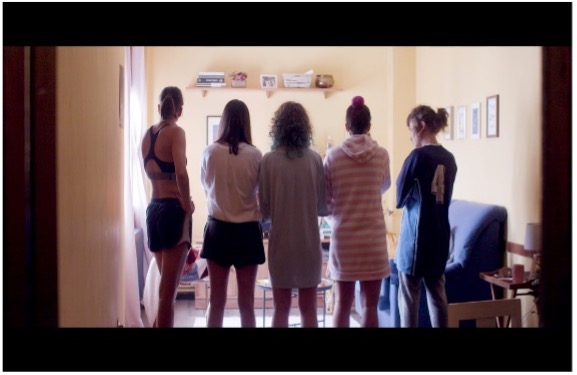This post is part of our Research Initiation Scheme for 2022-2023.
On Friday 4th November 2022, Dr Catherine Barbour (Twentieth and Twenty-First Century Spanish Peninsular Studies, Trinity College Dublin) delivered a seminar on the Galician webseries Monstras, directed by Eire García Cid, and how its feminist perspective compares with work more typical of what is known as Galician noir.
At the beginning of her presentation, Dr Barbour introduced the concept of Galician noir, a media genre sharing the key characteristics of Scandi noir with a strong sense of culture specific to the Galician community. There is frequently an undercurrent of rebellion, with anti-state sentiments mirroring the feelings of the region towards the Spanish state. Programmes and novels are almost exclusively in the Galician language – Monstras takes this a step further by having English subtitles rather than Spanish.

Image credit: Corentena Producións 2020
Dr Barbour then turned more specifically to Monstras itself, which was made available exclusively on YouTube from July 2020, the heart of the COVID-19 pandemic. It follows a group of women hiding out in their friend’s apartment after a violent act of revenge upon the man who sexually assaulted one of their friends. The production itself exudes anti-institutionalism; it was completely crowd-funded, with an exclusively female team.
Dr Barbour encouraged us to view the project as an example of “radical feminist counterculture”, which was emphasised by its unique narrative structure – the fictional story was interwoven with snippets of the MeToo movement, the Harvey Weinstein scandal, the English suffragettes, etc, as well as the reaction of the female characters during their revenge. The group howl like wolves – a link to the famous La Manada or ‘wolf pack’ assault case in Spain that took place in 2016.
Dr Barbour then drew our attention to Monstras’ representation of queer feminism. The main characters aren’t afraid to embrace activities which are stereotypically feminine, such as cooking and painting their nails, alongside attitudes which are more stereotypically masculine, e.g. picking their noses or, in Xulia’s case, having a PhD in a STEM (Science, Technology, Engineering and Mathematics) field. She also noted the homoerotic overtones and lack of heteronormativity in the main characters’ relationships; two of the women are a couple by the end of the series, and the only heterosexual relationship displayed is an unhealthy and abusive one.
Another theme at the heart of Monstras is sorority. The women taking refuge together in Julia’s flat glorifies the idea of the female ‘tribe’, composed of non-familial females sharing an intimate bond. They tackle domestic tasks together, working as a team to cook and clean the apartment, bucking the conventional isolationism of female labour in the home.
Finally, Dr Barbour underlined the clear link between the main characters of Monstras and the Furies of Greek mythology, the Goddesses of vengeance and retribution. This is the driving force behind the plot; the reaction of women to gender violence. It is worth noting that in noir male violence is often portrayed as being ‘justified’ in revenge for some ‘wrong’. Monstras subverts this stereotype with the ‘justifiable’ female violence and the focus being primarily upon the women during the attack – it focuses upon their faces, their reactions and their emotions, rather than the male victim.
Dr Barbour’s exploration of how Monstras destabilizes the Galician noir genre was insightful and thought-provoking. The next time I watch a female-driven project, I will ask myself how it might treat these themes and subvert the norms of the genre it is situated in.
Report by Sarah Kirkpatrick, final-year undergraduate in Common and Civil Law with Hispanic Studies